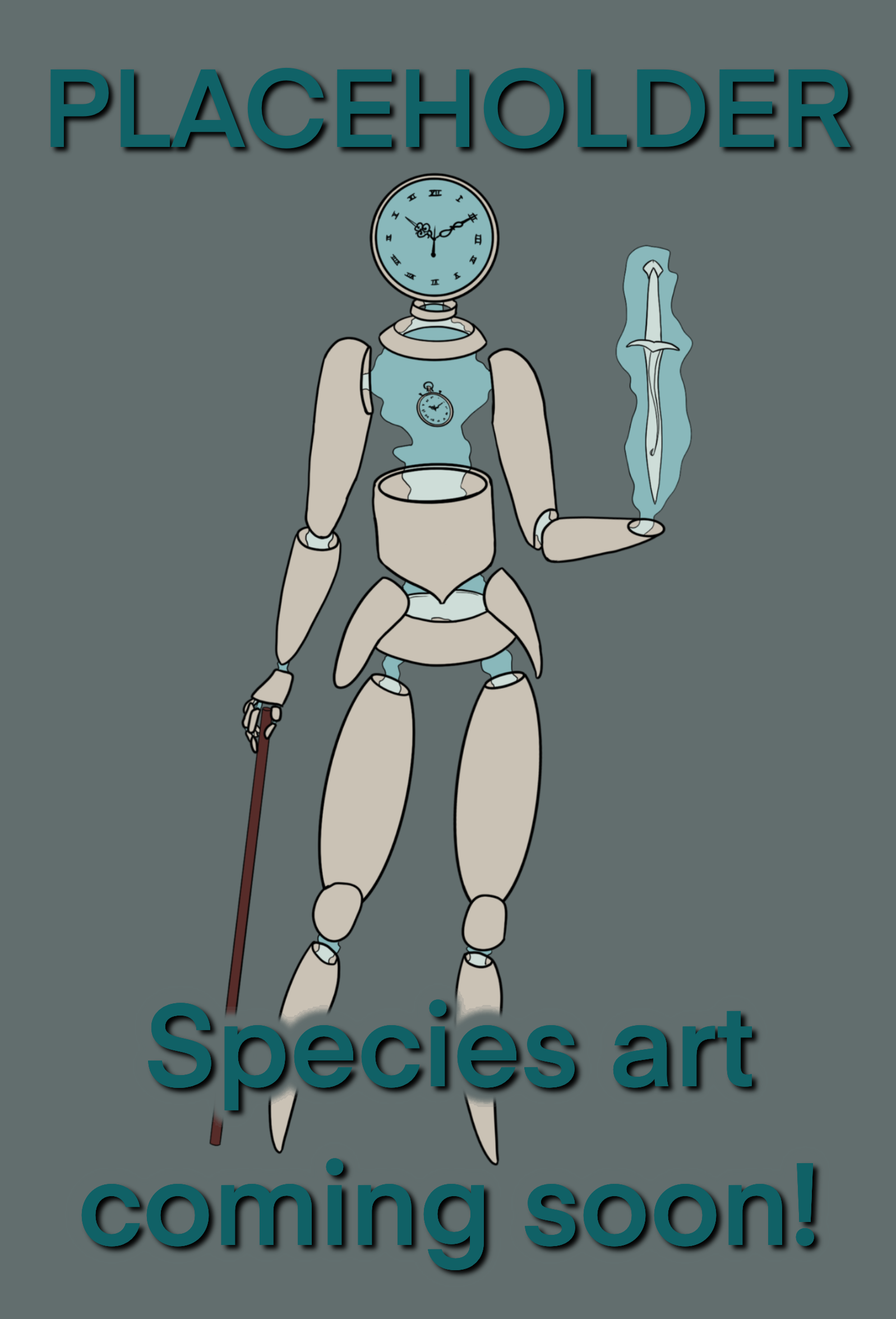Apollan
It appears this article is a stub! Alert the author if you'd like to see it expanded.
This article is a work in progress! Expect more content to be added.
This article was created for my Species-A-Day project for 2024! Read more here!
The worst part is that we knew it would happen, far in advance. But we knew there was nothing that we could do about it. Imagine that, seeing your own demise, and being forced to watch it come to pass. So no, I don't think our visions are a blessing. But I think they are necessary.Apollans are a near-extinct species native to the arid plains. They are prey in their own lands, hunted by the terrifying sand lions over three times their size. They live in pockets hidden underneath the sand, providing shade against their biome's terrifying heat. But the most notable aspect of the species are the lights that drift in front of their eyes, that only they can see. These lights, when correctly deciphered, can give them glimpses of information otherwise unattainable. Against their own will, the Apollans played a large role in the War of World's End, which left very few of them alive.
Basic Information
Anatomy
Apollans are a naturally tall species, most reaching at least 6 and a half feet tall in adulthood. Their arms each split into two forearms, each with a three-fingered hand on the end. On each of these fingers are long, claw-like nails - a trait that makes the species excellent at digging, but requires consistent trimming and upkeep. Their hair is thin and stringy, and many choose to shave it off entirely due to its undesireable appearance and little function. Their eyes have a glazed-over appearance, cloudy white in colour. Their skin tends to be darker browns, suited to the harsh sun of the biome they call home.
Genetics and Reproduction
Apollans have three sex chromosomes, technically maaking 27 possible sexes. However, only 6 combinations are actually capable of producing a healthy offspring. There are three types of sex chromosomes they can have: X, Y, and I. Every member of the species must have an I chromosome, as it contains biological traits for important aspects for survival, such as vision, lung growth, and bone development. Other than the I chromosome, and individual can have any mix of I, X, and Y chromosomes.
Apollans lay pouch-like eggs, similar to those of a shark. In order to gestate, these eggs must be buried under a thin layer of sand, to withstand the heat and draw in nutrients. The eggs are very fragile, and must be carefully protected - a 24/7 job for one of an egg's parents. Apollans tend to have 1-3 children in their lifetimes, each of whom live with their parents into adulthood.
Apollans lay pouch-like eggs, similar to those of a shark. In order to gestate, these eggs must be buried under a thin layer of sand, to withstand the heat and draw in nutrients. The eggs are very fragile, and must be carefully protected - a 24/7 job for one of an egg's parents. Apollans tend to have 1-3 children in their lifetimes, each of whom live with their parents into adulthood.
Growth Rate & Stages
The growth stages of an apollan depend on the individual's sex. Individuals with an X chromosome tend to develop faster, with only two clear stages - those of childhood and adulthood. Even then, the stages somewhat blur into one another. Individuals with a Y chromosome and no X chromosome develop slightly faster than those with III chromosomes, both able to be split into three stages: childhood, teenage, and adulthood.
Civilization and Culture
Naming Traditions
Apollans name their children after words in their language meaning things like "sun", "moonlight", or "bright one". Their names can be masculing, feminine, both, or neutral. Some more common feminine apollan names are Hestarene, meaning "sunlight", and Othtereo, meaning "rays of joy". Some common masculine names are Tyrtehal, meaning "brightest blaze", and Hyruth, meaning "moon's blessing". A name with both feminine and masculine aspects is Reuitaryet, meaning "the light of a full moon", and a name with neither is Xkhalahes, meaning "one who stands bright".
Major Language Groups and Dialects
The apollans speak a language that can be translated to mean Sunspeak. This language has a mix of "harsh" and "melodic" sounds, composing words that sound simultaneously like the unbearable heat of the sun and the life that it permits. This language is sacred to the apollans, and they do not appreciate outsiders learning it unless the outsiders choose to embrace the entirety of apollan culture.
History
The apollans have lived in the arid planes for milennia, and have adapted methods of hiding their societies at risk of being attacked by the sand lions native to the region. They were always a fairly peaceful society, but in the World Before, the other species who came into contact with them saw their prophetic visions as useful to them. They would coerce the apollans into working for them, destroying family homes and offering to rebuild only if the apollans joined them. This resulted in many apollans being spread across the planet, only a few remaining in the arid planes - those most hidden by their dwellings and dunes. In the War of World's End, the apollans that had been scattered ended up caught in the crossfire, with none surviving. By the time the War ended, only a handful remained, hiding in their homes.
Common Myths and Legends
Rather than typical worship of the worldmothers, the apollans believe that Amyrah is a manifestation of the sun, and Thyieni is a manifestation of the moon. They worship these worldmothers as well as the celestial objects they believe them to inhabit, both playing a crucial role in the culture of the arid plains.

Matilda Placeholder by notahumanhand
Lifespan
70-140 yrs.
Average Height
6.5-8 ft.
Body Tint, Colouring and Marking
Apollans can and often do have speckled spots across their body. These are seen as very attractive.
Geographic Distribution
Glimpses through Time
The Apollans have the incredibly rare ability to see pure time, manifesting in the form of moving lights in front of their eyes. As an apollan grows, they learn how to interpret these lights, which can convey information about the past, present, or future.These lights can range in shape, colour, size, distance, and movement, with many subtle changes that can make determining their meanings difficult. In addition to this, different interactions or combinations can change the meaning of a vision entirely, making proper inferrance of their meanings an art one must spend their lifetime practicing.
IXX: Typically referred to as female. Individuals with IXX chromosomes develop breast tissue, internal sexual organs, and less hair on their heads.
IXY: Typically referred to as demifemale. Individuals with IXY chromosomes develop breast tissue, smaller eyes, internal sexual organs, and more hair on their heads.
IYY: Typically referred to as male. Individuals with IYY chromosomes develop more hair on their heads, external sexual organs, and larger eyes.
IYI: Typically referred to as demimale. Individuals with IYI chromosomes develop external sexual organs, with a higher percentage being infertile or sterile.
III: Typically referred to as neuter. Individuals with III chromosomes develop few secondary sex characteristics, and underdeveloped sexual organs of any type. Most are infertile or sterile. They typically receive the most frequent and clear prophetic vision, but tend to be much rarer.
IXI: Typically referred to as intrafemale. Individuals with IXI chromosomes develop internal sexual organs, little to no hair on their heads, and darker, larger eyes.
IXY: Typically referred to as demifemale. Individuals with IXY chromosomes develop breast tissue, smaller eyes, internal sexual organs, and more hair on their heads.
IYY: Typically referred to as male. Individuals with IYY chromosomes develop more hair on their heads, external sexual organs, and larger eyes.
IYI: Typically referred to as demimale. Individuals with IYI chromosomes develop external sexual organs, with a higher percentage being infertile or sterile.
III: Typically referred to as neuter. Individuals with III chromosomes develop few secondary sex characteristics, and underdeveloped sexual organs of any type. Most are infertile or sterile. They typically receive the most frequent and clear prophetic vision, but tend to be much rarer.
IXI: Typically referred to as intrafemale. Individuals with IXI chromosomes develop internal sexual organs, little to no hair on their heads, and darker, larger eyes.




I love the variety of chromosomes and what each grouping means for their development. Poor apollans. I feel really sorry for them that they ended up exploited for their abilities. Sand lions sound terrifying. D:
Explore Etrea | March of 31 Tales
yeah, the War was really not a fun experience for any of them :(